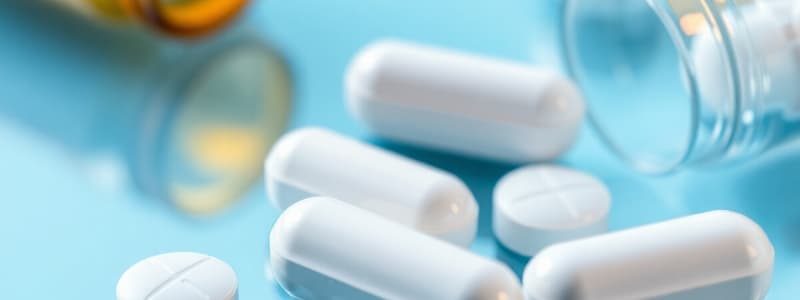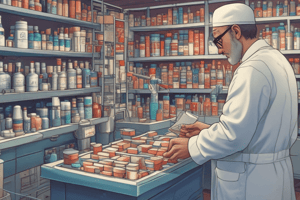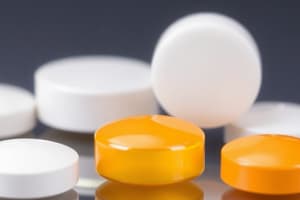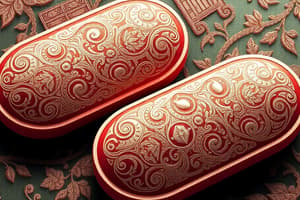Podcast
Questions and Answers
Which factor is essential in tablet formulation development when considering the chemical nature of drugs?
Which factor is essential in tablet formulation development when considering the chemical nature of drugs?
- The disintegration time
- The manufacturing facility
- The functionality of excipients (correct)
- The shape of the tablet
What is the most common shape of tablets produced?
What is the most common shape of tablets produced?
- Hexagonal
- Triangular
- Circular (correct)
- Quadratic
Which property of excipients is most important for ensuring uniformity in tablet production?
Which property of excipients is most important for ensuring uniformity in tablet production?
- Disintegration time
- Tensile strength (correct)
- Chemical reactivity
- Friability
Which manufacturing technology is characterized as fully programmable for high-speed tableting?
Which manufacturing technology is characterized as fully programmable for high-speed tableting?
Which of the following is NOT typically considered a critical quality attribute (CQA) for tablets?
Which of the following is NOT typically considered a critical quality attribute (CQA) for tablets?
What is a primary disadvantage of using Magnesium Stearate in tablet formulations?
What is a primary disadvantage of using Magnesium Stearate in tablet formulations?
How does Lubricant Material (LM) differ from Microcrystalline Cellulose (MCC) during the powder compaction process?
How does Lubricant Material (LM) differ from Microcrystalline Cellulose (MCC) during the powder compaction process?
What is the primary function of a disintegrant in tablet formulations?
What is the primary function of a disintegrant in tablet formulations?
What is the role of glidants in tablet manufacturing?
What is the role of glidants in tablet manufacturing?
Which of the following describes a characteristic of Magnesium Stearate as a lubricant?
Which of the following describes a characteristic of Magnesium Stearate as a lubricant?
What are the key advantages of using tablets as solid oral dosage forms?
What are the key advantages of using tablets as solid oral dosage forms?
What is preformulation in the context of solid dosage form design?
What is preformulation in the context of solid dosage form design?
How can the properties of dosage forms be modified based on patient needs?
How can the properties of dosage forms be modified based on patient needs?
Why is the study of excipients important in solid dosage formulation?
Why is the study of excipients important in solid dosage formulation?
What are the potential activities involved in the manufacture of solid oral dosage forms?
What are the potential activities involved in the manufacture of solid oral dosage forms?
Flashcards
Tablet Stability
Tablet Stability
Tablets generally exhibit superior chemical, physical, and microbiological stability compared to liquid dosage forms.
LM
LM
A pharmaceutical material, likely a type of powder, with a rough surface that results in high ejection force during tablet manufacturing.
Tablet Dosing Accuracy
Tablet Dosing Accuracy
Tablet preparation allows for precise drug measurement and administration, ensuring the correct dose.
MCC
MCC
Signup and view all the flashcards
Tablet Versatility
Tablet Versatility
Signup and view all the flashcards
MgSt
MgSt
Signup and view all the flashcards
Tablet Production Cost
Tablet Production Cost
Signup and view all the flashcards
Tablet Lubricant
Tablet Lubricant
Signup and view all the flashcards
Disintegrant/Superdisintegrant
Disintegrant/Superdisintegrant
Signup and view all the flashcards
Regular IR Tablets
Regular IR Tablets
Signup and view all the flashcards
Glidant
Glidant
Signup and view all the flashcards
Orally Disintegrating Tablets
Orally Disintegrating Tablets
Signup and view all the flashcards
Chewable Tablets
Chewable Tablets
Signup and view all the flashcards
Fragmentation
Fragmentation
Signup and view all the flashcards
Modified-Release Tablets
Modified-Release Tablets
Signup and view all the flashcards
Tablet Dissolution
Tablet Dissolution
Signup and view all the flashcards
Sublingual & Buccal Tablets
Sublingual & Buccal Tablets
Signup and view all the flashcards
Critical Quality Attributes (CQAs)
Critical Quality Attributes (CQAs)
Signup and view all the flashcards
Content Uniformity
Content Uniformity
Signup and view all the flashcards
Disintegration Time
Disintegration Time
Signup and view all the flashcards
Tensile Strength
Tensile Strength
Signup and view all the flashcards
Dissolution
Dissolution
Signup and view all the flashcards
Tablet Shapes
Tablet Shapes
Signup and view all the flashcards
Tablet Surfaces
Tablet Surfaces
Signup and view all the flashcards
Tablet Formulation Development (3W)
Tablet Formulation Development (3W)
Signup and view all the flashcards
Solid Oral Dosage Forms
Solid Oral Dosage Forms
Signup and view all the flashcards
Tablets
Tablets
Signup and view all the flashcards
Tablet Excipients
Tablet Excipients
Signup and view all the flashcards
Tablet Advantages
Tablet Advantages
Signup and view all the flashcards
Preformulation Studies
Preformulation Studies
Signup and view all the flashcards
Pharmaceutics
Pharmaceutics
Signup and view all the flashcards
Dosage Form Design
Dosage Form Design
Signup and view all the flashcards
Study Notes
Formulation Science - Solid Oral Dosage Form I
- Course: PR5217
- Instructor: Dun Jiangnan, Ph.D.
- University: National University of Singapore
- Semester: AY24/25.S1
- Date: 10-Oct-2024
Contact Information
- Email: [email protected]
- Office: S9 15-01F
- Office hours: By appointment only
- Response time: Typically 1-2 days; remind if not received
- Email questions: Limit to 3 per email
Learning Outcomes
- Understand the advantages of tablets
- Learn about common tablet excipients and their properties in solid formulations
Important Concept
- Pharmaceutics converts a drug into a medicine, and involves understanding physical chemistry, dosage form design, various manufacturing scales, and product performance testing.
Design of Solid Dosage Forms
- Preformulation Studies: Essential steps before formulation development to fully understand the physicochemical properties of drugs and other ingredients, and how they may interact in a dosage form. The data helps in designing the dosage form.
- Formulation: Involves understanding the small- and large-scale manufacturing, advantageous and disadvantageous properties of available dosage forms, and how modifying the properties of these forms relates to factors like administration route and patient needs.
Drugs in Solid State
- Drugs in solid-state can be administered as powders (e.g., metered-dose inhalers (MDIs)).
- Common solid oral dosage forms include tablets and capsules.
Learning Plan
- Week 8: Introduction to tablets.
- Week 9: Tablets II, and Capsules I; Quiz 1 (CANVAS)
- Week 12: Capsules II; Mini-Review; Quiz 2 (CANVAS)
Tablets
- 70% of drugs are administered orally in tablet form.
- Tablets are convenient, safe, robust, relatively inexpensive to mass-produce, and ensure quality and consistent preparation.
- They offer advantages over liquid dosage forms in terms of chemical, physical, and microbiological stability.
- They allow for precise dosing.
Types and Uses of Tablets
- Regular IR tablets: Immediate Release,
- Orally Disintegrating Tablets: Fast disintegration in mouth
- Chewable tablets: Designed for easy ingestion
- Modified Release tablets: Controlled release of the drug
- Sublingual/Buccal tablets: Under the tongue/cheek delivery, respectively.
Quality Attributes
- Critical Quality Attributes (CQAs) are characteristics impacting drug safety and efficacy.
- Content Uniformity
- Disintegration time
- Tensile strength
- Dissolution
- Friability
- Necessary for the successful quality dosage form of a tablet.
Tableting R&D: Lab-scale Instrument
- Various lab-scale instruments including Zwick, Presster, and Styl'One are used in pre-formulation studies.
Manufacturing of Tablets: The Rotary Press
- Automated tablet presses are used for high-volume manufacturing.
- Rotary press operation includes die filling, powder volume control, compaction, and tablet ejection stages
Toolings
- Different tooling shapes and designs are used to create tablets with various sizes, shapes, and markings, including break marks and symbols
- Typical tablet shapes found include circular, oval, and oblong as well as triangular, or quadratic.
Tablets Formulation Development (3W)
- Drugs: What kind of drug? Considerations include preformulation (PR 5225)
- Excipients: What kind of excipients? The type and amount of excipients to consider in the formulations. This includes chemical nature, functionality, and quantity.
- Technologies: What kind of manufacturing technologies?
Example: A Standard IR Tablet Formulation - Materials/Quantities/Categories
- Provided data includes materials, quantities in mg, categories, and their functionality.
Filler/Diluent
- Excipients used to increase tablet volume/weight
- Overcome poor properties of API materials
- Critical properties: powder flow, tablet strength
- Desired Properties: uniformity, disintegration time, dissolution, friability, and physical/chemical stability.
- Common examples: Lactose, Sucrose, Glucose, Mannitol, Sorbitol, Dicalcium phosphate dihydrate, Calcium carbonate, Cellulose.
Example 1: Microcrystalline Cellulose (MCC)
- Widely used as a filler in oral tablet formulations.
- Can also be used as a dry binder in granulation processes.
- Self-lubricated; low ejection force.
- Wood fiber, swells upon contact with water; can facilitate disintegration.
Crystalline and Amorphous Structure of Cellulose
- MCC isn't pure crystalline; includes amorphous regions.
Multiple Grades of MCC
- Different Avicel PH grades (PH 101, 102, 105, 200) have different primary particle size distributions and cohesive properties. (PH105 has the lowest primary particle size and highest cohesiveness).
Mechanical Properties of MCC
- Very plastic, readily deforms under low compaction pressure.
- Excellent mechanical properties; commonly used to overcome shortcomings in other drug compounds
- Sensitive to relative humidity (RH)
Selection of Excipient: MCC
- A guide to selecting the ideal MCC grade based on factors including batch size, nominal particle size, and moisture content.
- Various categories and properties highlighted.
Example 2: Lactose Monohydrate (LM)
- Primarily used as a filler/diluent in tablet formulations (e.g. Pharmatose 125M, SuperTab 30GR).
- Generally exhibits higher ejection force than MCC due to surface roughness.
Mechanical Properties of LM
- Manufactured in various grades, shapes, and surface properties.
- Unlike MCC, undergoes extensive fragmentation during powder compaction; creating new surfaces.
Lubricant: Magnesium Stearate (MgSt)
- Common tablet lubricant; high lubrication efficiency; economical.
- Forms physical layer on the tablet surface during manufacturing and ensures efficient flow and compaction.
Disadvantages of MgSt
- Diverse origins
- Hydrophobic
- Chemical impurities
- Phase impurities
- Poor flowability (cohesive)
MgSt may negatively impacts the MP
- This illustrates that the characteristics of MgSt can negatively influence other properties of the tablet. Specifically, it relates reducing friction but not necessarily increasing other properties like tensile strength.
Lubrication with MgSt Delays Tablet Dissolution
- Research articles on the effects of MgSt concentration on other aspects of the tablets.
Disintegrant/Superdisintegrant
- Added to ensure tablet breaks down in liquid.
- Low rate of drug dissolution
- Moderate rate of drug dissolution
- Rapid rate of drug dissolution
- Examples: Starch, cellulose, cross-linked polyvinylpyrrolidone (PVP), sodium starch glycolate, and sodium carboxymethylcellulose.
Glidant
- Improves powder flowability (e.g., Aerosil 200).
- Often added to granules before tableting to ensure even flow and mass achievement during high-speed manufacturing.
- Typically using <0.5% of a material like Aerosil 200.
Studying That Suits You
Use AI to generate personalized quizzes and flashcards to suit your learning preferences.




